|
|
|
Sort Order |
|
|
|
Items / Page
|
|
|
|
|
|
|
| Srl | Item |
| 1 |
ID:
162507
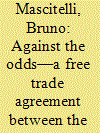

|
|
|
|
|
| Summary/Abstract |
The European Union (EU) and Australia have embarked officially on a free trade agreement (FTA) negotiation process, a procedure expected to last no less than 5 years. Public pronouncements from both sides which announced the beginning of the process of negotiating an FTA marked a significant departure from the well-known tensions and difficulties which date back to the late 1950s. British entry into the then European Economic Community in 1973 meant that it had to align its trade policies with the much contested European Common Agricultural Policy (CAP). This had been implemented in the late 1960s and provided limitless reasons for antagonism between Australia and the EU. Yet, over time, the trade agenda changed for both sides with new actors and new agreements, and some of the previous machinery no longer providing the liberalisation of trade as intended. Both the EU and Australia have moved on—some of this change due to new political actors and new economic realities. Despite the tortured history between them, and mindful that some might be sceptical about this change of heart, real politik often imposes its own political will and the new needs may well be in sharp contrast to the past relationships. The prospect of an FTA shows how the trappings of history might be side stepped by a stronger, almost opportunistic, sense of economic benefits however small they might appear.
|
|
|
|
|
|
|
|
|
|
|
|
|
|
|
|
| 2 |
ID:
021759
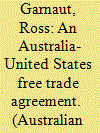

|
|
|
|
|
| Publication |
April 2002.
|
| Description |
123-141
|
|
|
|
|
|
|
|
|
|
|
|
|
|
|
|
| 3 |
ID:
052726


|
|
|
| 4 |
ID:
172217
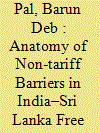

|
|
|
|
|
| Summary/Abstract |
This article attempts to answer one crucial research question: why the utilization of India–Sri Lanka Free Trade Agreement (ISFTA) route for trade is very poor by the Indian exporters (13%) as compared to their Sri Lankan counterpart (65%) even after one decade of its implementation? The available studies have blamed the non-tariff barriers (NTBs) which are hamstringing the growth of trade between these partners development of international trade. However, these have considered NTBs as subset of non-tariff measures (NTMs) which are quite narrow sense of finding the hidden barriers within the International trade process. Therefore, this article has analysed in detail the logistic process involved in international trade between India and Sri Lanka to understand various NTBs sheltered within this logistic process. Further, the article has identified issues which are not directly beyond the logistic process which are affecting the international trade between these two countries.
|
|
|
|
|
|
|
|
|
|
|
|
|
|
|
|
| 5 |
ID:
125273
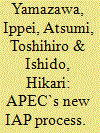

|
|
|
|
|
| Publication |
2013.
|
| Summary/Abstract |
In Order to fulfill the leaders` commitment 2010, all APEC economics have renews their IAP process under new guideline. An academic assessment of the efforts to achieve the Bogor goals in 2020 leads to the following question: How have they implemented in their IAPs the Bogor Goals progress report guideline adopted last year? How much have they achieved towards the Bogor Goals at the current stage? In which areas do they need to strengthen their implementation? This article seeks to objectively assess individual economics by individual area so that their remaining tasks will be clarified, although the mid-term assessment of 2010 adopted a group assessment of the thirteen economics, This paper makes an overall assessment and recommendations to the APEC SOM (Senior Office Meeting) regarding how to strengthen the new IAP process.
|
|
|
|
|
|
|
|
|
|
|
|
|
|
|
|
| 6 |
ID:
046593
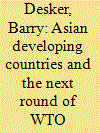

|
|
|
|
|
| Publication |
Singapore, Institute of Defence and Strategic Studies, 2001.
|
| Description |
21p.
|
| Series |
IDSS working paper; no. 18
|
|
|
|
|
|
|
|
|
|
|
|
Copies: C:1/I:0,R:0,Q:0
Circulation
| Accession# | Call# | Current Location | Status | Policy | Location |
| 045067 | 382.9/DES 045067 | Main | On Shelf | General | |
|
|
|
|
| 7 |
ID:
082367
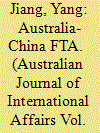

|
|
|
|
|
| Publication |
2008.
|
| Summary/Abstract |
This article seeks to explain why the Free Trade Agreement negotiation between Australia and China has been extremely difficult, despite political goodwill from Beijing and Canberra. It first argues that the reason for the slow progress of the negotiation is not caused by lack of motivation from the Chinese government. It then lists the differences in negotiation between China and Australia, focusing on their respective selective vs. comprehensive, border vs. behind-the-border, flexible vs. rigid and state vs. market approaches. It then looks into domestic politics in China to explain why China has taken such a stance, underlining domestic resistance from sectors like agriculture and services in a dynamic domestic political environment on the one hand, and the structure of the policymaking institution that constrains the power of trade negotiators on the other. It concludes by pointing out where the potential for a breakthrough in the FTA negotiation lies.
|
|
|
|
|
|
|
|
|
|
|
|
|
|
|
|
| 8 |
ID:
140725
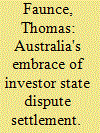

|
|
|
|
|
| Summary/Abstract |
This paper explores the origins of investor-state dispute settlement (ISDS) treaties and their implications for the Australian social contract. This analysis includes how and why ISDS emerged in NAFTA, was rebuffed with the failure of the Multilateral Agreement on Investment (MAI), and became incorporated into most subsequent bilateral US trade and investment agreements. The paper considers Australia's exposure to ISDS—first through using it in bilateral investment agreements in nations with inadequate governance mechanisms to support the rule of law, then turning against it when a multinational tobacco company tried to use the mechanism to overturn scientifically endorsed, democratically approved and constitutionally validated tobacco plain packaging measures. The paper concludes by exploring the hypothesis that an alternative governance vision can be achieved in which the system of investment arbitration and trade law is made coherent with presumptively more democratically legitimate normative systems such as constitutional and international law.
|
|
|
|
|
|
|
|
|
|
|
|
|
|
|
|
| 9 |
ID:
077199
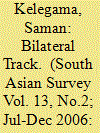

|
|
|
|
|
| Publication |
2006.
|
| Summary/Abstract |
The India-Sri Lanka Free Trade Agreement (ISLFTA) shows how bilateral cooperation can lead the way for regional cooperation. In operation, it has led to the rapid growth and diversification of Sri Lanka's exports to and imports from India. India's investment in Sri Lanka has also increased; India is now the second largest investor in Sri Lanka; and service sector cooperation has followed the growth of trade and investment. There were problems along the way but they were resolved. Moreover, this economic cooperation has overshadowed whatever political problems there were in the past. Now a Comprehensive Economic Partnership Agreement is expected to come into operation by the end of December 2006. The ISLFTA dispels the myth that economic cooperation between a large and small country benefits only the large country. Dormant complementarities can be invigorated through a bilateral free trade agreement, and new comparative advantages can be discovered, further stimulating trade.
|
|
|
|
|
|
|
|
|
|
|
|
|
|
|
|
| 10 |
ID:
159687


|
|
|
|
|
| Summary/Abstract |
The free trade agreement (FTA) between Australia and the European Union holds the promise of strengthened political collaboration and increasing economic integration. Both Australia and the European Union note increasing bilateral trade and investment. Oftentimes, data does not take current trends in global-value-chain participation for intermediary goods and services movements into account. Behind this sit the cross-border strategies and activities of business entities, whether multinationals or large, small or medium-sized enterprises. This article provides an in-depth investigation of the premise stemming from an FTA for Australian business. What advantages can politics hope to support through a business perspective? What is the global-value-chain part of the story, and what are the business challenges ahead? How can economic policy help shape this FTA to foster a productive bilateral business environment in a geopolitical and geoeconomic context in which regionalisation has taken on new momentum? Specific focus is given to the analysis of the higher education sector and to agriculture. These are two of the leading sectors in this FTA debate. Generating business value means setting negotiation agendas to target tariff and non-tariff barriers to counterbalance ambiguity in the conditions that shape the global business environment.
|
|
|
|
|
|
|
|
|
|
|
|
|
|
|
|
| 11 |
ID:
106349
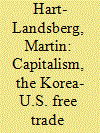

|
|
|
|
|
| Publication |
2011.
|
| Summary/Abstract |
Free trade agreements (FTAs) have become an essential part of the corporate effort to establish a global infrastructure suitable to its contemporary accumulation dynamics. Because they establish and reinforce patterns of economic activity that are destructive of majority interests, they should be opposed. This article scrutinizes one agreement: the Korea-U.S. FTA. It examines the motivations that led to its negotiation, the content of the agreement, and the arguments U.S. government officials and institutions have made in support of its ratification. It concludes with a critical evaluation of the efforts of U.S. and Korean opponents of its ratification and a call for a new organizing strategy.
|
|
|
|
|
|
|
|
|
|
|
|
|
|
|
|
| 12 |
ID:
069305
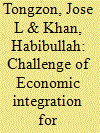

|
|
|
| 13 |
ID:
128891
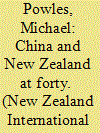

|
|
|
| 14 |
ID:
095330
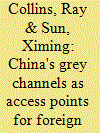

|
|
|
|
|
| Publication |
2010.
|
| Summary/Abstract |
Grey channels, which are neither clearly legal nor clearly illegal, are commonly relied on by international firms as a means of accessing Chinese markets. Firms report that they use grey channels to avoid China's high import tariffs, difficult regulatory hurdles, and inefficient distribution networks. For food products, grey channels involve risks such as unreliability in delivery and inadequate cool chain management, and some authors anticipate that the use of grey channels for such products will diminish when China implements WTO standards. To explore opportunities that may exist in a free trade environment, this article analyzes what a grey channel is, why people use it, how it operates, and what advantages and disadvantages it has in comparison with other channels. This leads to a discussion on the future of grey channels. The analysis is based on in-depth interviews with firms involved in the food trade in China and Hong Kong.
|
|
|
|
|
|
|
|
|
|
|
|
|
|
|
|
| 15 |
ID:
149059
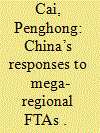

|
|
|
|
|
| Summary/Abstract |
This paper explores China’s responses to mega-regional negotiations, including the Trans-Pacific Partnership and the Regional Comprehensive Economic Partnership. By examining Chinese elite discourse, the policy-oriented study finds that China’s approach is related to the domestic political debate on a “second WTO accession” and China’s strategy toward the changing regional architecture.
|
|
|
|
|
|
|
|
|
|
|
|
|
|
|
|
| 16 |
ID:
075495
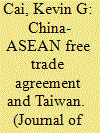

|
|
|
|
|
| Publication |
2005.
|
| Summary/Abstract |
While China's move toward a FTA with ASEAN reflects Beijing's most recent foreign economic policy adjustment and represents a new stage in the nation's open-door policy, it inevitably produces significant impact on cross-Taiwan Straits relations. This recent development in China's foreign economic relations brings not only substantial psychological and real effects and pressure on Taiwan for its possible isolation and marginalization from the ongoing process of regional integration in East Asia, but also growing pressure exerted by the island's business community that fears being pushed into a disadvantageous position in competition with ASEAN companies in the ever expanding and lucrative market of the mainland. For strategic, diplomatic, and economic considerations in the face of this new challenge, Taiwan is pursuing counter-measures by searching for its own FTAs with other countries within and beyond the region.
|
|
|
|
|
|
|
|
|
|
|
|
|
|
|
|
| 17 |
ID:
059512
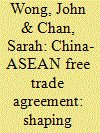

|
|
|
|
|
| Publication |
May-Jun 2003.
|
|
|
|
|
|
|
|
|
|
|
|
|
|
|
|
| 18 |
ID:
128918
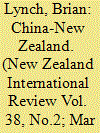

|
|
|
| 19 |
ID:
113696


|
|
|
|
|
| Publication |
2012.
|
| Summary/Abstract |
The role of China in East Asia's recovery from the recent global financial and economic crisis highlights China's position as an engine of growth for this region. From the viewpoint of China, there are many potential gains from entering into free trade agreements (FTAs) with its neighbors, who collectively form a large and fast-growing market. In this paper, we qualitatively and quantitatively assess the four main permutations of China's FTAs with East Asian major economies: China-ASEAN, China-Japan, China-Korea and ASEAN+3. We compare the effects of these FTAs on China's output and welfare. Our comparative analysis shows that China will gain from all three bilateral FTAs, while gaining the most from the ASEAN+3. Because forming a region-wide FTA, such as the ASEAN+3, is expected to be gradual and difficult, China should continue to engage in bilateral FTAs as a medium-term and alternative strategy. However, in the long term, China should pursue a region-wide FTA.
|
|
|
|
|
|
|
|
|
|
|
|
|
|
|
|
| 20 |
ID:
167330
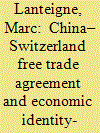

|
|
|
|
|
| Summary/Abstract |
The free trade agreement signed between China and Switzerland in 2013 was a watershed event in the economic policies of both states, a successful identity-building exercise for both actors in addition to an economic endeavour. In the case of Beijing, the Switzerland free trade agreement (FTA) was a crucial step not only in promoting its trade interests in Europe, including the European Union, but also in planning future FTAs and promoting China as a supporter of globalization and economic liberalisation. For Switzerland, the FTA further cemented that country’s identity as a distinct European economic and political actor, including in its engagement of the Chinese market.
|
|
|
|
|
|
|
|
|
|
|
|
|
|
|
|
|
|
|
|
|